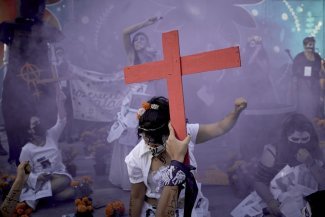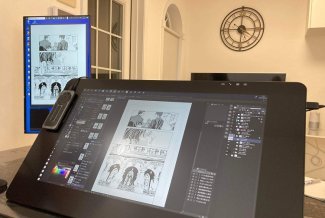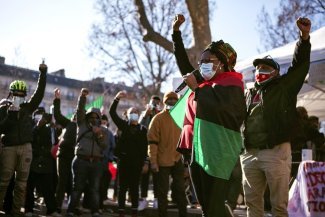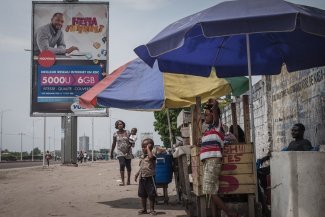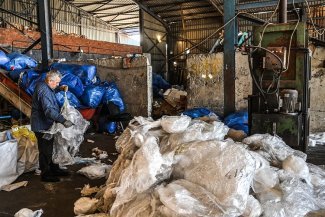Just over 28 years ago (3 September 1990), Transnistria, a region wedged between Ukraine and the Dniester River, declared its independence from Moldova. This unilateral separation, not recognised by any UN member states – and followed by a civil war – created a kind of political limbo in which the self-proclaimed republic’s roughly 500,000 citizens continue to live today.
In addition to its population and actively policed borders, Transnistria has its own government and armed forces. It prints its own currency and issues its own passports – neither of which are recognised. The Transnistria conflict is one of several “frozen conflicts” in the region (which could impact Russia, the EU and NATO) – as far as the outside world is concerned, the republic doesn’t exist.
“When they declared independence, they promised us that we were going to build a little Switzerland here. We believed it. Why not? We had the potential,” says Svetlana (who requested that her name be changed), a resident of Tiraspol, the capital city of Transnistria (and the second largest city in Moldova).
Before its secession, Transnistria was the most prosperous region of the Moldavian Soviet Socialist Republic (MSSR) and an industrial powerhouse that supplied the rest of the territory with electricity, generating approximately 40 per cent of Moldova’s GDP. It’s where the country’s political elites came from and where Soviet troops were stationed. The economy in Bessarabia, the Romanian-speaking part of Moldova, was centred on agriculture, particularly wine production. On the eve of the fall of the USSR, the standard of living in Transnistria was twice as high as the rest of Moldova.

Commemoration in Tiraspol of the USSR’s victory in World War II. After separation, the government of Trasnistria decided to keep Soviet symbols in opposition to the new symbolism of Moldova.
“Do you guys have oligarchs too?” Svetlana asks me. A retired professor of biochemistry, Svetlana works part-time to help her daughter and grandchildren. After a long and fruitless search for employment, her eldest son, also an academic, gave up and trained instead to be an electrician. He now works in Poland on a seasonal basis.
Svetlana fondly remembers the days of the Soviet Union. For her, the problems started with the fall of the USSR and the rise of nationalist sentiment. “Suddenly, neighbours started shooting at each other. No one understood what was going on. The people at the top were at war with one another and those of us on the bottom were paying the price,” she says.
“The conflict wasn’t an ethnic one as such, even if identity and language played an important role for both sides,” explains Gilles-Emmanuel Jacquet, professor at the Geneva School of Diplomacy and Investigator at the International Peace Institute in Geneva. “In reality, the Transnistrian and Moldovan elites were trying to maintain or gain power. Linguistic, cultural and ethnic problems served as a pretext,” he adds.

Local producers and farmers sell their goods at Tiraspol’s Green Market. The land and infrastructure belongs to the private conglomerate, Sheriff.
After declaring its independence, the Transnistrian government privatised the bulk of the region’s industry. Most of the companies were taken over by Russian and Ukrainian oligarchs or became property of the Russian state. In the early 1990s, two former members of MSSR special services founded Sheriff, a private conglomerate with ties to the family of Igor Smirnov, Transnistria’s first president. Today, Sheriff controls virtually all of the region’s political and economic life. Its assets include supermarkets, banks, refineries, distilleries, pharmacies, a mobile phone network, a clothing factory and a football team.
Transnistria’s unilateral declaration of independence isolated the region and placed it in a legal limbo that paved the way for poverty and the development of inequality.

A match between local team FC Sheriff Tiraspol and FC Milsami Orhei, from Moldova. Both the football stadium and the FC Sheriff team belong to the Sheriff conglomerate. However, FC Sheriff is registered as a Moldovan team, as this is the only way for it to participate in international competitions.
“We should really be called ‘the Republic of Sheriff,’” jokes Anton, a 38-year-old entrepreneur (who also asked us not to use his real name), not without a hint of bitterness in his tone. “They’re the ones who decide everything here. In theory you can build up your own business, but you always run the risk of encroaching on their territory.”
Anton spent years working in Europe, saving money to buy a flat in central Tiraspol. His flat now functions as a small hostel in which statues and portraits of Lenin are basic elements of decoration. “People like it,” Anton says with a smile, “They come here to see the last Soviet vestige in Europe.”

The parliament of Transnistria in Tiraspol, with a statue of Lenin in the foreground. The current government celebrates its Soviet past, but in reality pursues free market economic policies.
“It’s a normal country, not a museum!” exclaims Kira, an entrepreneur from Tiraspol. “We don’t ride through the streets on horses and we don’t spend our days staring at Lenin! For us, it’s just a part of history.”
Kira, 24, lives in a flat with standards comparable to those in Europe. The spacious living room with leather armchairs and the high-end electrical appliances in the kitchen indicate a high standard of living. Kira studied marketing and economics in Odessa (southern Ukraine) and France but wanted to return to Transnistria. “We have everything we need here and everything is much easier than in Europe. You can achieve a lot if you want to.”
At 22, Kira opened a café in the centre of Tiraspol. To start her business, she needed US$5,000, the equivalent of about three years of an average salary in Transnistria. “We received the money as a wedding present. Part of it was for our honeymoon and the rest was for the business. My husband [Alex] knew I wasn’t going to stay at home with my son. We did the decorations ourselves and now my aunt works in the café.”

Kira at home with her husband, Alex, and their son in Tiraspol.
Alex, 28, also runs a plastics and packaging company. His main client is Sheriff’s supermarket network and his company is registered in Moldova. “It gives him access to a much broader market. Business is business,” adds Kira.
Kira considers herself to be patriotic and speaks proudly of her family’s achievements: her grandfather, Sergey Leontiev, one of the central figures in the fight for independence, served as vice president from 2001 to 2006; her father, Oleg Leontiev, is a deputy for Renewal, the political party currently in power. Kira smiles when I ask her if she plans to get involved in politics. “I have a lot of work with my business now. Maybe in the future.”

The kitchen of an orphanage for children between 6 and 17 years old, Parkany, close to Tiraspol. Many parents who decide to emigrate leave their children with relatives or in orphanages.
For the majority of Transnistria’s inhabitants, however, the picture is not so rosy. The lack of employment forces many to leave the country in search of work. According to a study conducted by the International Organization for Migration (IOM), in 2015 alone, close to 15 per cent of the working population left the region permanently. Most are young people who choose Russia as their destination. Little by little the country is becoming depopulated, with only children and the elderly remaining behind.
“I’m not going to sacrifice myself for a country that has nothing to offer me,” says Olga, 22, who dreams of being an actress in Europe (and who is also using a fake name). “There’s nothing here, there’s no independent culture and the culture that we do have is controlled by the government.”
Olga is currently looking for work while she waits for a Romanian passport. “I feel Transnistrian, but I can’t go anywhere with the papers from here,” she explains. “I already have a Russian passport but a Romanian one would allow me to live in Europe.” As she says, you have to be patient – with the number of applications submitted, it can take up to three years to get an appointment in the consulate.
Many young people in Transnistria want to live ’normal’ lives – to be able to travel, have recognised diplomas, attend universities in foreign countries or simply to buy goods, like any other European.
“I love this country but there’s so much that we lack. I would love for an Ikea to open here so we could buy normal furniture instead of having to go to Moldova or Ukraine,” says Sascha, 24.

Sascha, like many of her fellow citizens, has more than one passport: Transnistrian, Russian and Moldovan (from left to right).
In Sascha’s family, talking about Moldova was once a delicate subject. Her father fought for independence and was taught in school that Moldovans were the enemy. Her travels made her question a lot of things. “I realised that not everything was as black and white and that everyone has their own version of history. If I had been able to, I would have done everything possible to avoid war. Nothing good comes from separation.”
Politicians, however, opt for a discourse much more based on identity.
“The slogan ‘Suitcase – Train – Russia’ sticks with me to this day,” says Marina Kovtun, president of the Renewal party, in the city of Grigoriopol. “They wanted to throw us out of here and look, not only are we still here but we’ve shown the world that we’re capable of surviving on our own. European politicians say that they don’t recognise us, but they come here to do business and we export to several European countries!”

The ODEMA garment factory in Tiraspol. During the Soviet era, this factory employed 7,000 people and supplied the whole of the USSR. Today only 530 people work there.
In truth, local goods can only be sold abroad if they are labelled as Moldovan products. Financial transactions have to be made at Russian banks or directly in Moldova since the local currency is not recognised. The lack of political normalisation discourages many foreign investors, while some local companies can only offer cheap labour to European brands.
“85 per cent of our production is made for foreign companies, mostly German,” explains Aleksander Swiderski director of ODEMA, a textile factory located in Tiraspol. “They send us materials, models and machinery and we have to deliver them a finished product, with the company’s brand on it and labelled as made in Moldova. The factory continues to function but neither the company nor the local population is actually developing.”

Like many other veterans of World War II, Sergei Nikolaievich receives his pension from Russia, a pension that is three times higher than what the Transnistrian authorities pay.
“Transnistria has been able to survive this long thanks to Russian economic support,” explains G.E. Jacquet. “Putin never recognised it as a state, but he provides a lot of aid in order to keep it under his control.”
One good example is the supply of gas through a Russian-Moldovan agreement, for which the Transnistrian government hasn’t paid in years. By mid-2014, the bill had reached US$4 billion (about €3.5 billion). At the same time, the primary consumers – and debtors – of the gas are the industrial plants that belong to oligarchs and the Russian state. Putin’s government also supports the development of small businesses, renovates and builds public buildings and hospitals, offers scholarships for students and pays for a large number of retiree pensions.

Vadim Krasnoselsky (pictured right, talking) won the presidential election in 2016 with the support of the oligarchs and the Sheriff conglomerate. He seeks closer economic ties with Moldova while at the same time maintaining a separatist discourse.
All of this further reinforces the widespread impression of being part of the Russian orbit, an idea that has never been popular with Transnistria’s Moldovan minority.
“This is my land too!” says Veronica, a teacher in one of the few Moldovan secondary schools in Transnistria. “My whole family was born here and those that left after independence have to apply for a visa to visit us. There are Russian flags and Transnistrian flags flying everywhere here, but if I put up my Moldovan flag, they’ll brand me a nationalist.”
For many, however, the question of identity is becoming less and less important. Local politicians, even those who maintain a separatist discourse, favour reinforcing economic ties between the two sides. As some interviewees told me, “Identity doesn’t fill your stomach.”





